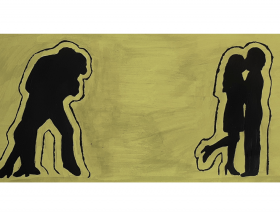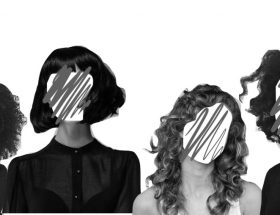Hoops, studs, cuffs, drop earrings. Fashion accessories, cultural identifiers, rites of passage, even methods of rebellion. For centuries, earrings have featured in every culture and in every material available. However, as a Sephardi Jewish woman, there remains a sinister history to these seemingly innocuous accessories that adorn my ears. Centuries ago, wearing earrings would not have been a choice for my ancestors, nor the final touch to an outfit, but instead a requirement to distinguish us as Other. To separate us from the rest of society.
From the earrings of 14th/15th century Italy to the yellow stars of Nazi Germany, clothing has consistently been used as a weapon to trap my people. To remove the possibility of being yet another anonymous member of society and to provide a clear, easy mark, a bullseye, for prejudice. The further I researched, the angrier I became and the more helpless I felt in a world that still identifies us as Other.
In order to understand why earrings were considered as objects degrading enough to be viewed as appropriate identity distinguishers, it is useful to refer back to their place and meaning in iconoclastic art. From the 12th century mosaic in the basilica on the island of Torcello, Venice, in which heathens sentenced to eternity in hell are portrayed as wearing earrings, to the conscious decision of removing the earrings from Mary’s lobe to signify the rejection of her Jewish past in favour of her Christian belief in Giovanni Bellini’s Presentation to the Temple c.1460, earrings were deemed un-Christian and therefore unacceptable.

Although the above is directed to the values of modesty and self-control, I must admit that it is nevertheless unclear to me whether this was related to the requirement of focusing on a higher power, without the distractions of physical adornments, or as viewing the pierced lobe as impure or as a mutilation of the body. In order to not offend, nor make any further blundering mistakes with regard to the symbolism of earrings in Christianity, I will return to the focus of the article: how these objects were used to segregate and, therefore, negatively impact the Jewish community.
This segregation through appearance ensured that earrings were objects that enforced hierarchy in society. This is because, by the middle of the 15th century, Jews were assimilated into Italian culture to such an extent that it was difficult to distinguish them from Christians. This “shocking” revelation that Jews were not some inferior breed, but rather similar to the rest of society, could not be abided by the various Italian authorities. It was seen as shameful or offensive to the name of Christ that the two could not be distinguished. Although the ways in which Jews were distinguished ranged from various forms of red or yellow cloth sewn to their garments, it is to the yellow O that I would like to draw attention. In 1430, the Venice city council passed a ruling that all Jewish men over the age of 12 were to wear an O of yellow cord sewn on their clothing at chest height. In contrast, the yellow Os worn by Jewish women were on their ears. In fact, in the 14th century Emilian city in Southern Italy, it was decreed that all Jewish women over the age of 10 had to wear “rings hanging from both ears, which should be and remain uncovered and visible to all” (Hughes, 1986). Those women who were known to be Jewish but were not wearing earrings were fined for having left their identity at home and, therefore, threatening society through their subversion.
This enforcing of appearance and dress to differentiate people is a form of Othering still very omnipresent today. With regards to the Jewish community, moving away from the literal to the more figurative form, consider more broadly the concept of stereotyping of Jews. Big noses, pale skin, dark curly hair, etc…stereotypes I am sure many of you are familiar with. However, it is this very ignorant stereotype perpetuated by the media, whether in films, cartoons, newspapers or other forms, that not only negates the existence of every Jew of colour, but is also burdened with many toxic, prejudiced, false connotations which actively brand Jews out for discrimination. Take my mother, for example: a Sephardi Latina Jew, often thrown out of Taxis for fitting some categories of a stereotype. Negating her rich and diverse Sephardi Jewish background and reducing her to the two-dimensional label of JEW. Reducing her to a single word to be spat out in an anti-Semitic tirade.
However, the way in which we have bias towards people from what we see in their appearance or dress is not only applicable to religious groups, but to all individuals. How people perceive and categorize others is intrinsically linked to how someone dresses and the connotations that are attached to physical attributes. Take for example the relationship between someone’s race, their dress, and its association with criminality. A person wearing a tracksuit, especially if they are a person of colour, will disproportionately mark the person out for harassment or arrest for NO REASON other than people in positions of power (usually of an opposing racial, religious, or political group) having decided that a certain form of dress must become an identifier of the Other. A clear mark to which prejudice can be directed. Trayvon Martin. 17 years of age. Sanford, Florida. 26.02.2012. A black teenager wearing a black hoodie. An innocent boy, wearing a piece of clothing which, on its own is meaningless, but in the eyes of the prejudiced, of the racist, is an excuse for suspicion. An excuse for senseless hatred. A vehicle to justify crimes in line with what those in positions of legislative or cultural authority decide is subversive, dangerous.
How short was her skirt. She had it coming. Another instance where the prejudiced in power try to cover their own shortcomings and poisonous discourse by placing the onus on clothing; on how that changes the way we view a person. By utilising dress as a distraction, it is essentially providing a physical, easily visible scapegoat to which the anger, violent tendencies, prejudices, and their justification can be directed.
These biases, whether unconscious or, more likely, conscious, have existed for centuries and will unfortunately continue for many more. However, it is the choice of the individual to reconsider, to educate, and to stand up to those who seek to enforce it. Spend less energy differentiating groups and more actively contributing to building a society which is united and focused on celebrating diversity, rather than actively suppressing it. If our modern day society is as progressive and developed as it claims, then surely it’s time to leave Othering behind and to ensure that imposed identity markers of hatred are things of the distant past.
Art by Jennifer van der Merwe




